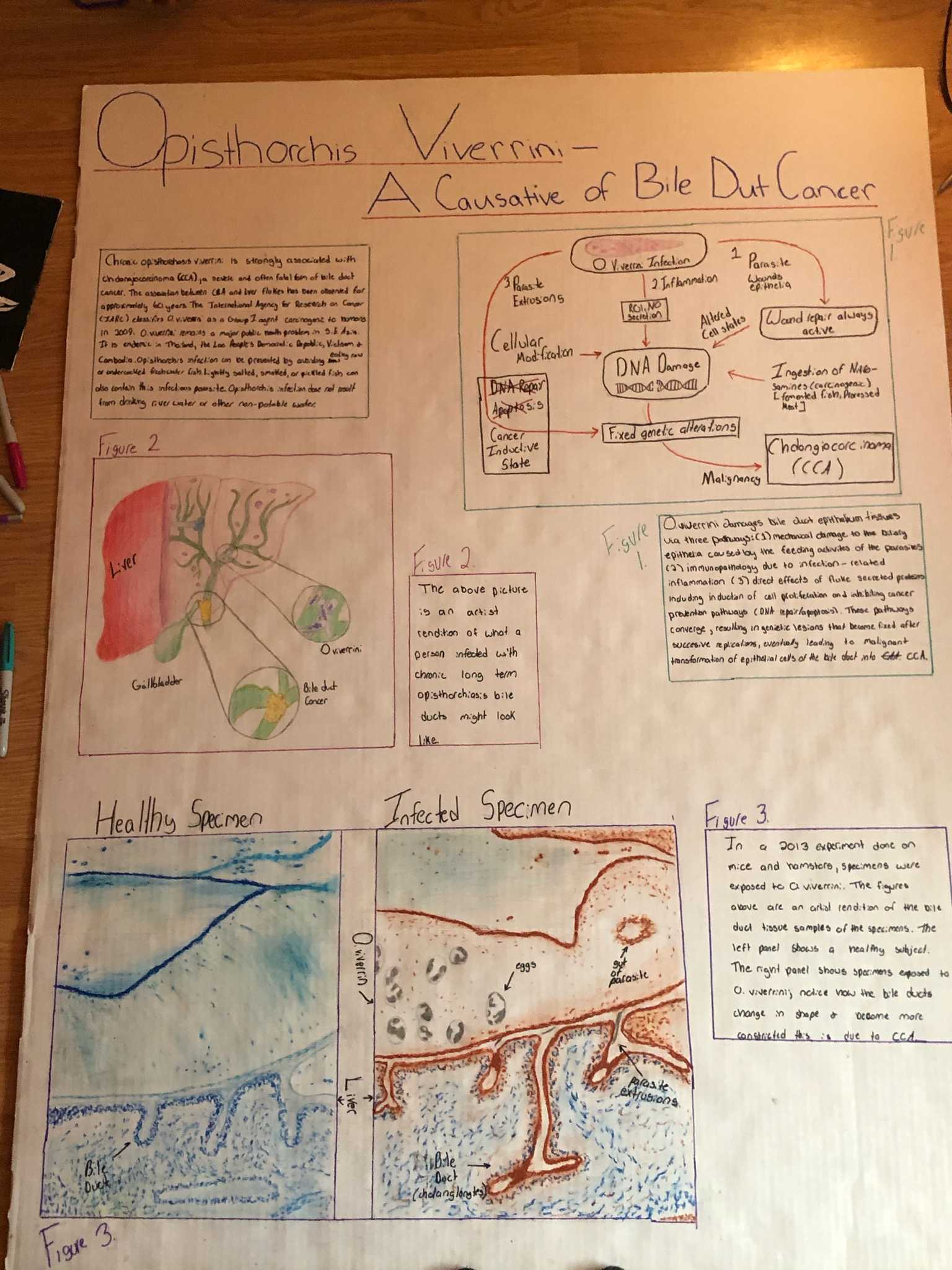Opisthorchiasis viverrini is a parasitic liver fluke (a type of flatworm). This parasite is more commonly known as the Southeast Asian liver fluke and is a common infection of the civet cat and other fish-eating mammals, such as domestic cats and dogs. People are infected after eating raw, salted, pickled, smoked, marinated, dried, partially cooked, or poorly processed fish, thus ingesting the parasite. Once inside you this parasite migrates to your bile ducts. O. viverrini is strongly associated with cholangiocarcinoma (CCA), a severe and often fatal form of bile duct cancer. The association between CCA and liver flukes has been observed for approximately 60 years. I choose to do this project on O. viverrini because I found it very interesting how it can increase the risk of bile duct cancer. I also think parasites are gross and interesting so I became interested in this liver fluke quickly. If I got this parasite I would cry. 🙂

This is what is on my poster just incase you can’t see from the picture.
Project Title: Opisthorchis Viverrini — A Causative of Bile Duct Cancer
Chronic opisthorchiasis viverrini is strongly associated with cholangiocarcinoma (CCA), a severe and often fatal form of bile duct cancer. The association between CCA and liver flukes has been observed for approximately 60 years. The International Agency for Research on Cancer (IARC) classifies O. viverrini as a Group 1 agent (carcinogenic to humans) in 2009. O. viverrini remains a major public health problem in the in Southeast Asia. It is endemic in Thailand, the Lao People’s Democratic Republic, Vietnam, and Cambodia. Opisthorchis infection can be prevented by avoiding raw or undercooked freshwater fish. Lightly salted, smoked, or pickled fish can contain infectious parasites. Opisthorchis infection does not result from drinking river water or other non-potable water.
Figure 1.
O. viverrini damages bile duct epithelium tissues via three pathways: (1) mechanical damage to the biliary epithelia caused by the feeding activities of the parasites (2) immunopathology due to infection-related inflammation (3) direct effects of fluke secreted proteins including induction of cell proliferation and inhibiting cancer prevention pathways (DNA repair/apoptosis). These pathways converge, resulting in genetic lesions that become fixed after successive replications, eventually leading to malignant transformation of epithelial cells of the bile duct into CCA.
Figure 2
The above picture is an artist rendition of what a person infected with chronic long term opisthorchiasis bile ducts might look like.
Figure 3
In a 2013 experiment done on mice and hamsters, specimens were exposed to O. viverrini. The figures above are an artist rendition of the bile duct tissue samples of the specimens. The left panel shows a healthy subject. The right panel show specimens exposed to O. viverrini; notice how the bile ducts change in shape and become more constricted this due to CCA.

In Parades steam project, he made a poster of Opisthorchiasis viverrini. This is a parasitic liver flatworm that get into your bile ducts by eating raw fish. When this flat worm gets into your system, I may develop a bile duct cancer to grow. There are 4 different ideas that are in this poster. The first section is where they talk about the history of where this parasite originated and how can people and other fish-eating living creatures can get this. The next demonstrates the pass way of how the Opisthorchiasis viverrini gets into the bile ducts. The next figure shows an example of how this parasite would look like it there was an x-ray to the liver and how the bile ducts may look when it gets a cancer. The last figure talks about an experiment done on mice and hamster when they were exposed to this parasite. The picture one shows how it suppose to look when the animals were healthy and the other picture on the right shows when Opisthorchiasis viverrini gets into the animal.